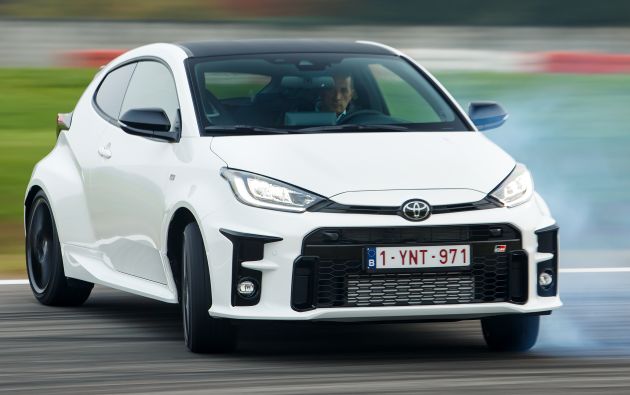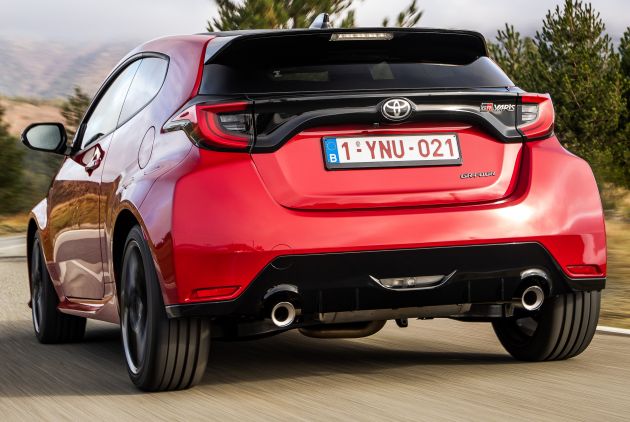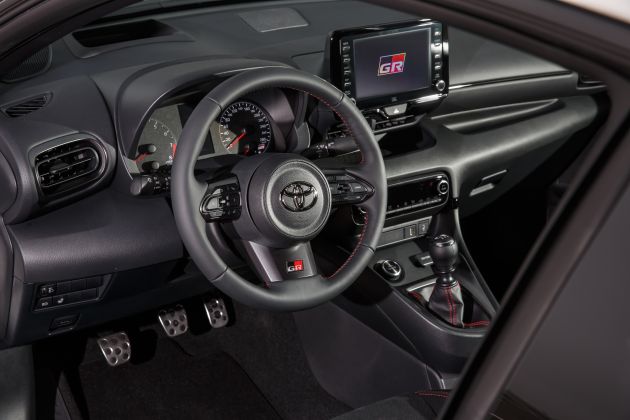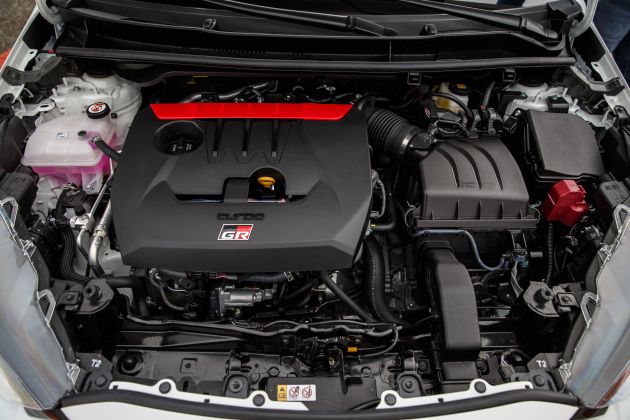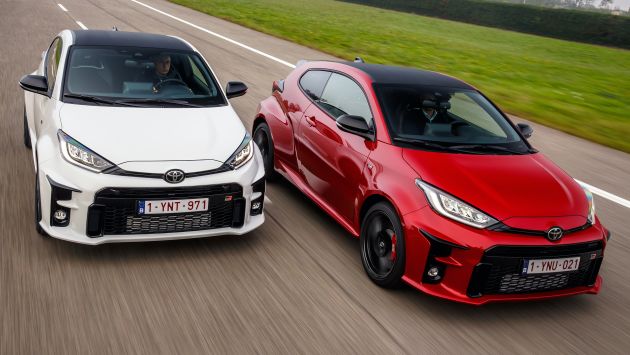The Toyota GR Yaris has gone on sale in Europe, bringing rally-inspired performance to the continent. The company has released a veritable deluge of images and information to go with the availability of this highly anticipated pocket rocket, the second global GR product after the Supra.
Being the brand’s first sports car to be fully developed in-house in two decades, the GR Yaris has a lot riding on its shoulders. So it’s just as well that Toyota has pulled out all the stops, endowing the hatchback with a bespoke three-door body (the standard European-market Yaris is five-door only) and underpinnings.
The body shell was optimised for World Rally Championship (WRC) aerodynamic regulations, so it’s 60 mm wider (1,805 mm) and 45 mm lower (1,455 mm) than the regular Yaris. The trailing edge of the roof is actually a whopping 95 mm lower, allowing for a more efficient rear wing on the rally car. And despite having fewer doors, the GR Yaris is actually 55 mm longer (3,995 mm), though its 2,560 mm wheelbase is unchanged.
As you can imagine, the significant rejigging of the proportions means that the GR Yaris doesn’t share any body panels with the cooking model, with only the lamps, door mirrors and antenna being carried over. The front end has been geared for cooling with the addition of a large rectangular lower grille, feeding air into the engine, radiator and intercooler, while vertical intakes on either side cool the brakes.
Adding to the car’s purposeful nature is the downforce-producing front splitter, which has a raised centre section to control the airflow going under the car. This is complemented by the upper and lower corner lips that frame the fog light surrounds and function as canards to generate downforce in the corners.
You also have the much wider front and rear fenders, with the flared rear arches being particularly flat to smoothen airflow leaving the car and reduce drag. The glasshouse also tapers to improve aerodynamic performance at the back of the car, where you’ll find a large diffuser and twin tailpipes. Underfloor airflow has also been improved with flat covers and front wheel spats.
The dashboard has been largely carried over but with a few detail changes. The 4.2-inch multi-info display gets a screen that shows the workings of the all-wheel-drive system, the setup of which can be manipulated using the rotary controller ahead of the gearlever. Speaking of which, the shifter has been raised by 50 mm, putting it closer to the driver’s reach and allowing for faster shifts.
Also fitted are sports seats with increased cushion padding and thinner backs, a three-spoke GR steering wheel and specially-positioned sports pedals. As for practicality, the GR has a much smaller boot at just 174 litres, though you can still fold the 60:40 split-folding rear seats for more luggage space if you so wish.
The bespoke componentry extends to the engine, a G16E-GTS 1.6 litre turbocharged three-cylinder engine. Touted as both the largest and most powerful three-cylinder in production as well as the smallest and lightest 1.6 litre turbo around, it comes with D-4S port and direct injection, as well as a single-scroll turbo integrated with the exhaust manifold. Outputs for the European model are rated at 261 PS at 6,500 rpm and 360 Nm of torque from 3,000 to 4,600 rpm, 11 PS and 10 Nm down on the Japanese one.
The GR Yaris is only available with a six-speed manual gearbox, complete with a rev-matching function. The GR-Four all-wheel-drive system has been developed specifically for the car – the first such system in 20 years – and ditches the heavy centre differential in favour of a multi-plate clutch in the rear differential to distribute torque to the front and rear wheels.
Drivers have three different settings for the torque split to choose from. In Normal mode, the car sends around 60% to the front wheels and 40% to the rear, whereas Sport mode has a 30:70 split to add some rear-drive handling characteristics. Track mode dials it back to a 50:50 split for maximum performance. The Circuit Pack adds Torsen limited-slip differentials at the front and rear to shuffle torque from side to side.
This all-wheel-drive system is the reason why Toyota has spliced up two of its platforms for the GR Yaris. The front end retains the same GA-B underpinnings as the standard car, but the rear end uses the C variant from the Corolla and C-HR instead. This allows the fitment of double wishbones at the rear, making space for the differential and half shafts.
At the front, the MacPherson strut suspension has been retained but sports reinforced hub bearings, lower arms and their associated bushings, plus revised anti-roll bars and redesigned knuckles that increase negative camber and optimise the car’s roll steer characteristics. The bespoke dampers have increased response, while the steering has been retuned for greater alacrity and feedback.
The GR Yaris comes as standard with 18-inch alloy wheels and Dunlop SP Sport Maxx 050 tyres, hiding ventilated brake discs that measure 356 mm at the front (even larger than the Supra’s) and 297 mm at the rear. These are clamped by four-piston callipers at the front and two-piston units at the rear. A manual handbrake replaces the Yaris’ electronic parking brake, and the rear axle is disconnected when it is pulled while moving to allow drivers to slide into a corner.
The Circuit Pack throws in GR-badged red callipers, lightweight BBS alloys and Michelin Pilot Sport 4S tyres, along with stiffer springs and anti-roll bars, retuned dampers and tweaked power steering settings to take advantage of the extra grip.
Going hand-in-hand with the uprated chassis, the body shell has been stiffened and lightened for this application, with increased spot welds and structural adhesive and a reinforced rear end. A forged carbon roof and aluminium doors, tailgate and bonnet shave around 27.5 kg and enable the body to weigh around 38 kg less than the previous Yaris. All-in-all, the GR Yaris tips the scales at 1,280 kg.
Despite the performance bent, the car doesn’t compromise on safety, fitted with the full Toyota Safety Sense suite of driver assists. These include autonomous emergency braking with oncoming vehicle detection, daytime cyclist detection and nighttime pedestrian detection, lane centring assist, lane keeping assist and automatic high beam.
In Germany, the GR Yaris is priced starting from €32,363 (RM157,500), although the Circuit Pack bumps it up to €36,740 (RM178,800). By comparison, the larger Honda Civic Type R retails at €37,032 (RM180,200). Malaysian distributor UMW Toyota has hinted at the car’s possible arrival here, where it will likely retail north of the RM300,000 mark. Can’t wait? You can drive one in Gran Turismo Sport starting tomorrow.
Source: Read Full Article

